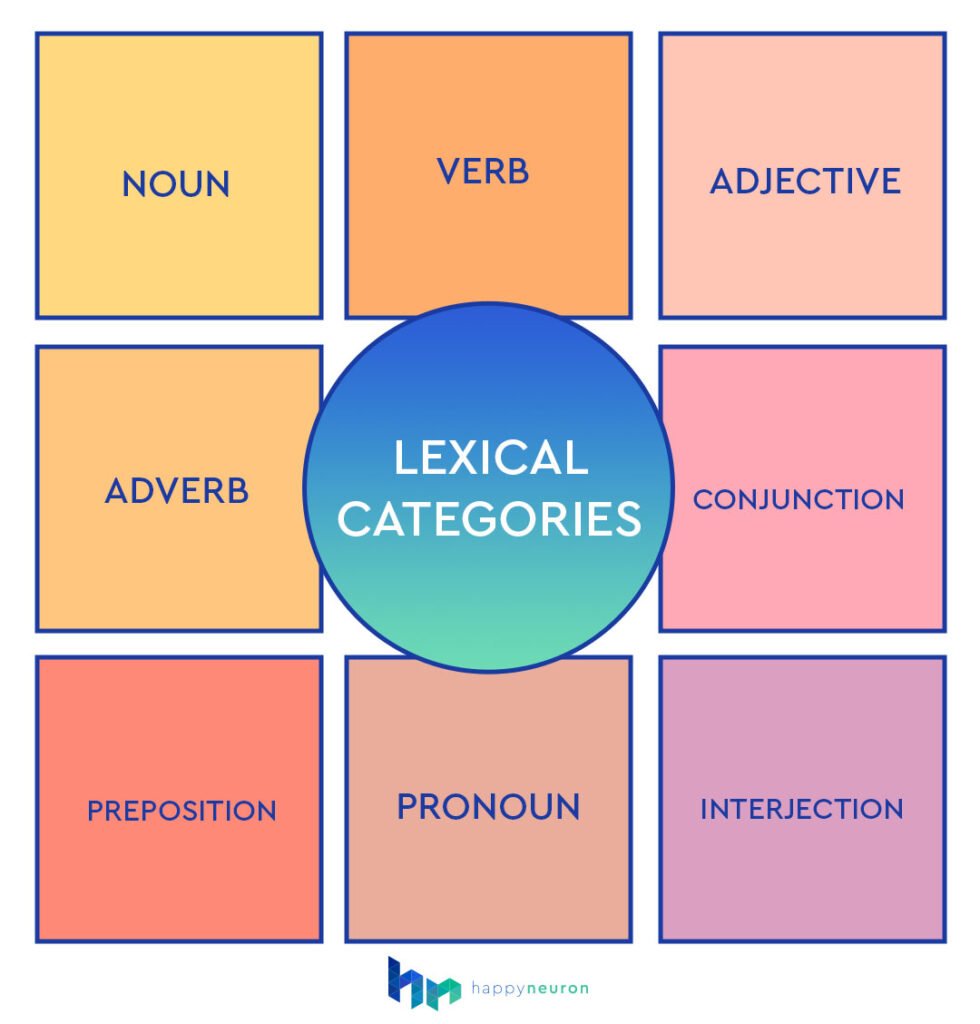
Language is a multifaceted tool we use daily to express ourselves, communicate ideas, and connect with others. Understanding lexical categories, also known as parts of speech, is crucial for effective communication within the realm of language. Lexical categories are the building blocks of language that help us categorize and understand words based on their functions and meanings. This page will delve into what lexical category skills entail and explore cognitive exercises to enhance these skills.
Lexical categories, or parts of speech, are the different classes into which words can be categorized based on their grammatical properties and usage in sentences. The main lexical categories include nouns, verbs, adjectives, adverbs, pronouns, prepositions, conjunctions, and interjections. Each category serves a distinct purpose in conveying meaning and structure in language.
1. Nouns: Nouns are words that represent people, places, things, or ideas. They can be concrete such as “dog” or “city.” Or, they can be abstract concepts such as “love” or “happiness.”
2. Verbs: Verbs express actions, such as “jump” or “give,” or states of being, such as “is” or “are.” They are essential for describing what happens in a sentence.
3. Adjectives: Adjectives modify nouns and provide additional information about their qualities. Examples of adjectives are “beautiful,” “interesting,” and “scary.”
4. Adverbs: Adverbs modify verbs, adjectives, or other adverbs to indicate manner, time, place, or degree. Examples of adverbs are “quickly,” “very,” or “boldly.”
5. Pronouns: Pronouns replace nouns to avoid repetition and make sentences more concise. For example, “he,” “she,” “we,” and “it” are all pronouns. Rather than say, “Dave came over, and then Dave and I went for a walk,” pronouns can streamline the sentence. “Dave came over, and we went for a walk.”
6. Prepositions: Prepositions establish relationships between nouns or pronouns and other words in a sentence. Examples of prepositions are “on,” “in,” and “under.”
7. Conjunctions: Conjunctions connect words, phrases, or clauses within a sentence. Examples include “and,” “but,” and “or.”
8. Interjections: Interjections are expressive words or phrases used to convey emotions or reactions, such as “wow,” “ouch,” and “oh.” This lexical category does not depend on other grammatical connections, so they interject in sentences or can be used on their own as a sentence. For example, “Wow! I didn’t realize you had such good grades” or “Oh, I thought we were ordering pizza.”
Most sentences are made up of at least a noun and a verb. An example of a complete sentence is “Ty joked.” It only contains a noun and a verb, and that’s technically all you need to create a complete sentence.
Of course, we can utilize more lexical categories to convey much more information, like “Ty joked loudly in class about his dog eating his favorite sneakers.”
Now that we have a basic understanding of lexical categories let’s explore some cognitive exercises to improve proficiency in identifying and using them effectively!
Lexical category skills may be affected by learning disabilities, brain injuries, or other cognitive impairments. They may also simply not be an individual’s strong suit. In any of these cases, it can be helpful to exercise these skills. Here are some ways to exercise knowledge of lexical categories:

1. Sentence Parsing:
– Exercise: Analyze sentences in a text and identify the lexical category of each word.
– Example: “The dog chased the ball.” (Noun – dog, ball; Verb – chased)
2. Categorization Games:
– Exercise: Play games that involve sorting words into their respective lexical categories.
– Example: Sort a list of words into categories such as nouns, verbs, adjectives, etc.
3. Sentence Construction:
– Exercise: Construct sentences using words from different lexical categories.
– Example: “The energetic (adjective) dog (noun) quickly (adverb) chased (verb) the fluffy (adjective) squirrel (noun).”
4. This Story Is Full of Blanks is a great exercise for this, as the user must use context clues to determine what lexical category is needed and understand which lexical category each word available to them belongs to.
5. Seize the Keywords is a great way to challenge your client’s ability to recognize and remember lexical categories. In this exercise, they must recall the verbs in a passage and sort them in the correct order. It activates lexical categorization skills and working verbal memory ability.
6. Storytelling:
– Exercise: Practice storytelling while consciously incorporating a variety of lexical categories.
– Example: Tell a story using a mix of nouns, verbs, adjectives, and other parts of speech to create vivid imagery.
7. Word Association:
– Exercise: Prompt word association games where participants respond with words from specific lexical categories.
– Example: Start with a word like “ocean,” and players respond with related nouns (e.g., “waves,” “beach”).
Working on lexical category skills helps improve language proficiency and communication effectiveness. By engaging in cognitive exercises focused on identifying, categorizing, and utilizing different parts of speech, individuals can strengthen their grasp of language structure and enhance their ability to express themselves fluently and accurately. Through games, exercises, or practical applications, investing time and effort into developing lexical category skills can benefit spoken and written communication.
Pulling from our decades of experience in Cognitive Therapeutics, we aim to help you enrich your practice through the use of digital and paper tools.
Pricing + Offers


© 2023 HappyNeuron is a Product of Humans Matter